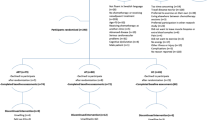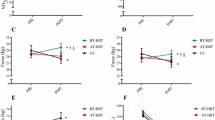Abstract
Purpose
The purpose of this study was to determine the effects of an 8-week HIIT intervention on patient-reported outcomes and physical function in breast cancer patients undergoing anthracycline-based chemotherapy.
Methods
Thirty breast cancer patients were recruited prior to initiating treatment and randomized into the HIIT group (n = 15) or control (CON) group (n = 15). The HIIT group attended HIIT sessions three days per week for eight weeks. The CON group was asked to maintain their current level of physical activity. Patient-reported outcomes were assessed by the Functional Assessment of Cancer Therapy-Breast Cancer (FACT-B), Multidimensional Fatigue Inventory with 20 questions (MFI-20), and the 15-item Five-Facet Mindfulness Questionnaire (FFMQ-15). Physical function was assessed using the timed up and go (TUG), 30-s sit-to-stand (30STS), Margaria-Kalamen stair climb test, and 6-min walk test (6MWT). Repeated measures ANCOVA and paired t-tests were performed to assess group differences.
Results
All patients completed the 8-week study with 82.3% adherence to the intervention among the HIIT group. Post-intervention, significant improvements were found for the Margaria-Kalamen stair climb test (− 3.39%; P = 0.013) and 6MWT (+ 11.6%; P = 0.008) in the HIIT group compared to baseline and CON group. No changes in patient-reported outcomes, TUG, and 30STS were observed following the 8-week study period in both groups (P > 0.05).
Conclusions
HIIT may be an effective strategy to improve physical function and possibly maintain QOL in breast cancer patients undergoing the anthracycline-based chemotherapy.
Clinical trial registration
ClinicalTrials.gov: NCT02454777
Similar content being viewed by others
Data availability
The datasets used and/or analyzed during the current study are available from the corresponding author on reasonable request.
Code availability
Not applicable.
References
Giordano SH et al (2012) Decline in the use of anthracyclines for breast cancer. J Clin Oncol 30(18):2232
Gilliam LA, St DK (2011) Clair, Chemotherapy-induced weakness and fatigue in skeletal muscle: the role of oxidative stress. Antioxid Redox Signal 15(9):2543–2563
Mills PJ et al (2005) The relationship between fatigue and quality of life and inflammation during anthracycline-based chemotherapy in breast cancer. Biol Psychol 69(1):85–96
Wong ML et al (2018) Characteristics associated with physical function trajectories in older adults with cancer during chemotherapy. J Pain Symptom Manage 56(5):678-688.e1
Hofman M et al (2007) Cancer-related fatigue: the scale of the problem. Oncologist 12(1):4
Manir KS et al (2012) Fatigue in breast cancer patients on adjuvant treatment: course and prevalence. Indian J Palliat Care 18(2):109
Sehl M et al (2013) Decline in physical functioning in first 2 years after breast cancer diagnosis predicts 10-year survival in older women. J Cancer Surviv 7(1):20–31
Patel AV et al (2019) American College of Sports Medicine roundtable report on physical activity, sedentary behavior, and cancer prevention and control. Med Sci Sports Exerc 51(11):2391–2402
Campbell KL et al (2019) Exercise guidelines for cancer survivors: consensus statement from international multidisciplinary roundtable. Med Sci Sports Exerc 51(11):2375–2390
Troeschel AN, Leach CR, Shuval K, Stein KD, Patel AV (2018) Peer reviewed: physical activity in cancer survivors during “Re-entry” following cancer treatment. Prev Chronic Dis 15:E65
Mugele H et al (2019) High-intensity interval training in the therapy and aftercare of cancer patients: a systematic review with meta-analysis. J Cancer Surviv 13(2):205–223
Choi H-Y et al (2018) Superior effects of high-intensity interval training compared to conventional therapy on cardiovascular and psychological aspects in myocardial infarction. Ann Rehabil Med 42(1):145
Coetsee C, Terblanche E (2017) The effect of three different exercise training modalities on cognitive and physical function in a healthy older population. Eur Rev Aging Phys Act 14(1):13
Thum JS et al (2017) High-intensity interval training elicits higher enjoyment than moderate intensity continuous exercise. PLoS ONE 12(1):e0166299
Lee K et al (2018) Effects of high-intensity interval training on vascular function in breast cancer survivors undergoing anthracycline chemotherapy: design of a pilot study. BMJ Open 8(6):e022622
Lee K et al (2019) Feasibility of high intensity interval training in patients with breast cancer undergoing anthracycline chemotherapy: a randomized pilot trial. BMC Cancer 19(1):653
Nguyen J et al (2015) EORTC QLQ-BR23 and FACT-B for the assessment of quality of life in patients with breast cancer: a literature review. J Comp Eff Res 4(2):157–166
Krohe M et al (2019) Content validity of the National Comprehensive Cancer Network-Functional Assessment of Cancer Therapy-Breast Cancer Symptom Index (NFBSI-16) and Patient-Reported Outcomes Measurement Information System (PROMIS) Physical Function Short Form with advanced breast cancer patients. Health Qual Life Outcomes 17(1):92
Wintermann G-B et al (2018) Fatigue in chronically critically ill patients following intensive care-reliability and validity of the multidimensional fatigue inventory (MFI-20). Health Qual Life Outcomes 16(1):37
Gu J et al (2016) Examining the factor structure of the 39-item and 15-item versions of the five facet mindfulness questionnaire before and after mindfulness-based cognitive therapy for people with recurrent depression. Psychol Assess 28(7):791
Morishita S et al (2019) Assessment of the mini-balance evaluation systems test, timed up and go test, and body sway test between cancer survivors and healthy participants. Clin Biomech 69:28–33
Eden MM, Tompkins J, Verheijde JL (2018) Reliability and a correlational analysis of the 6MWT, ten-meter walk test, thirty second sit to stand, and the linear analog scale of function in patients with head and neck cancer. Physiother Theory Pract 34(3):202–211
Schmidt K et al (2013) Validity of the six-minute walk test in cancer patients. Int J Sports Med 34(07):631–636
Hetzler RK et al (2010) Development of a modified Margaria-Kalamen anaerobic power test for American football athletes. J Strength Cond Res 24(4):978–984
Nedeljkovic A et al (2007) Evaluation of Margaria staircase test: the effect of body size. Eur J Appl Physiol 100(1):115–120
Mijwel S et al (2018) Adding high-intensity interval training to conventional training modalities: optimizing health-related outcomes during chemotherapy for breast cancer: the OptiTrain randomized controlled trial. Breast Cancer Res Treat 168(1):79–93
Mijwel S et al (2018) Highly favorable physiological responses to concurrent resistance and high-intensity interval training during chemotherapy: the OptiTrain breast cancer trial. Breast Cancer Res Treat 169(1):93–103
Courneya KS et al (2007) Effects of aerobic and resistance exercise in breast cancer patients receiving adjuvant chemotherapy: a multicenter randomized controlled trial. J Clin Oncol 25(28):4396–4404
Lipsett A et al (2017) The impact of exercise during adjuvant radiotherapy for breast cancer on fatigue and quality of life: a systematic review and meta-analysis. The breast 32:144–155
Farthmann J et al (2016) The impact of chemotherapy for breast cancer on sexual function and health-related quality of life. Support Care Cancer 24(6):2603–2609
Cámara RJ et al (2019) Quality of life during and after adjuvant anthracycline-taxane-based chemotherapy with or without Gemcitabine in high-risk early breast cancer: results of the SUCCESS A trial. Breast Cancer Res Treat 175(3):627–635
Acknowledgements
We acknowledge the Clinical Investigations Support Office of the Norris Comprehensive Cancer Center for their regulatory support of this investigation and the extraordinary generosity of our study participants.
Funding
This work was supported by grant UL1TR001855 from the National Center for Advancing Translational Science (NCATS) of the U.S. National Institutes of Health. The content is solely the responsibility of the authors and does not necessarily represent the official views of the National Institutes of Health.
Author information
Authors and Affiliations
Contributions
Conceptualization (all authors); methodology (Kyuwan Lee and Christina Dieli-Conwright); writing original draft (all authors); review & editing (all authors); resources (Christina Dieli-Conwright), and supervision (Christina Dieli-Conwright). All authors have read and approved the manuscript.
Corresponding author
Ethics declarations
Ethics approval
The protocol was approved by the University of Southern California Institutional Review Board (HS-1500227); ClinicalTrials.gov: NCT02454777; date of registration: May 27th, 2015.
Consent to participate
The informed consent was approved by the University of Southern California Institutional Review Board (HS-1500227); ClinicalTrials.gov: NCT02454777; date of registration: May 27th, 2015.
Consent for publication
Not applicable.
Conflict of interest
The authors declare no competing interests.
Additional information
Publisher’s note
Springer Nature remains neutral with regard to jurisdictional claims in published maps and institutional affiliations.
Kyuwan Lee and Mary K. Norris are co-first authors
Rights and permissions
About this article
Cite this article
Lee, K., Norris, M.K., Wang, E. et al. Effect of high-intensity interval training on patient-reported outcomes and physical function in women with breast cancer receiving anthracycline-based chemotherapy. Support Care Cancer 29, 6863–6870 (2021). https://doi.org/10.1007/s00520-021-06294-7
Received:
Accepted:
Published:
Issue Date:
DOI: https://doi.org/10.1007/s00520-021-06294-7




